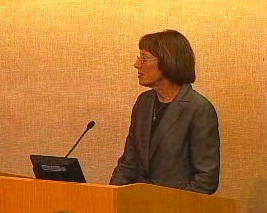
A lot of parents want their children go to Christopher High School, or at least it would seem, looking at the number of families willing to lie about where they live to attend it.
So much so, that between 100 and 150 students currently attending CHS have lied about their place of residency to get into the $110 million facility according to Gilroy Unified School District Superintendent Debbie Flores. Issues stemming from families falsifying their address have arisen since the high school opened in 2009 and have got to stop, Flores said, and the district isn’t messing around anymore.
Some parents are up in arms over GUSD’s move to hire a part-time “residency verification specialist” – a retired police officer from the City of Santa Clara to extensively question eighth-graders who say they live within CHS boundaries, but whose authenticity of that residency is suspicious.
One such parent who calls it an invasion of privacy and an assault on personal rights is Rachel Valenzuela. Her son, Jadon, an eighth-grader at Solorsano Middle School, was unexpectedly pulled out of a final exam last month to be questioned by the district’s investigator, Brian Allen.
Frightened and confused, Jadon sat with Allen in a conference room at Solorsano. Allen introduced himself as someone who works for the superintendent and assured Jadon he was not in trouble before launching into a series of rapid-fire personal questions, Valenzuela said.
“I mean, the questions came like bang, bang, bang. Who do you live with? Are they your real parents? How many siblings? Do your parents rent or own? It was like an interrogation,” Valenzuela said.
At the end of the 30-minute session, Allen told Jadon he was investigating children because some families are lying to get into CHS.
Angry that her son had to make up his final exam, Valenzuela was also baffled that Jadon was questioned at all, considering that his older brother attends Gilroy High School, where Jadon is all set to attend in the fall.
“He’s even picked his classes. We have nothing to do with Christopher High,” she said.
Valenzuela sent a letter to Flores and this newspaper, complaining about Jadon’s needless “interrogation.” After a back-and-fourth email chain between Valenzuela and Flores, Flores explained that Jadon was questioned by mistake.
“I acknowledge that your son’s file was inadvertently given to Mr. Allen when it should not have been,” Flores wrote to Valenzuela.
Flores also said that Jadon should not have been pulled from a final to be questioned, no matter the circumstance, and apologized to Valenzuela on behalf of Allen and Solorsano’s staff.
“This is the first year we’ve done this. There will be some hiccups,” Flores told the Dispatch last week.
The issue of residency fraud has been a pebble in GUSD’s shoe for several years. Handling the dilemma has been a topic of discussion at multiple Board of Education meetings and fodder for angry parents and teachers, who in the past have written letters to the Dispatch wanting to expose the “rampant” problem.
“This is fraud,” Flores confirmed. “At this point we are not going to the next step of reporting it to the District Attorney’s Office, which we could do.”
In January, GUSD sent a letter to all parents of eighth-grade students warning them about the upcoming crackdown on residency fraud.
“It is really sad that the district must expend limited resources in this manner, but this unethical behavior cannot be tolerated,” the letter read.
GUSD Trustee Mark Good believes the district’s “very overdue and very welcome” action of hiring Allen is an effective method to squelch the problem. As for the reaction from parents complaining about their child being interviewed without their consent, Good scoffed.
“The district has the right to conduct a reasonable investigation based on a reasonable cause,” he said. “We’re not ostriches sticking our heads in the sand.”
But Valenzuela – and about a dozen other parents who have complained to Allen about the process – maintains the district should handle the problem another way.
“Apparently they have the right to do this, but that doesn’t mean it’s OK,” she said. “I understand this is a difficult issue, but an interview with a child should be the last resort.”
Valenzuela wishes Allen had dropped by the house to speak with her instead, where he could have quickly learned that her family has not falsified anything.
Kimberly Thomas Rapp, executive director at the San Francisco-based Lawyer’s Committee for Civil Liberty, agreed that the school district has a right to take these steps to verify residency. But she is also concerned that children are being interviewed by someone they don’t know – and an ex-police officer to boot.
“It’s about whether or not the district is taking steps to bypass adults by directly questioning children in a manner that is intimidating,” Thomas Rapp said. “It’s not a teacher or a familiar adult, and it’s someone with a law enforcement background. There are concerns this raises about possible impropriety.”
Flores hired Allen after learning that school districts in Cupertino and Santa Clara successfully handled the issue of residency fraud by using a retired police officer to investigate suspicious families. Allen, who works for GUSD on a part-time temporary basis, is paid $40 an hour including travel expenses.
“We are trying to limit the costs, but there are costs of not doing this too. We’re hoping that we’ll get the word out that we are taking this very seriously, so we may not need him much at all next year,” Flores said.
All of Allen’s student interviews are conducted with the door open with other staff members in hearing range – and despite what angry parents say, Flores insists that Allen does not “interrogate” children.
Flores said Allen also conducts home visits, parental interviews, landlord interviews and drive-bys of the homes in question – all of which she says the district has the legal right to do.
“This is fraud. At this point, we are not going to the next step of reporting it to the District Attorney’s Office, which we could do,” Flores said.
The district’s office, along with Allen’s help, sifted through student data to narrow the list down to 25 to 30 suspicious families – namely, families who have been living in the GHS zone for years and all of a sudden reported a change of address to the CHS zone. GUSD does not plan to reprimand any current CHS students who have lied about their residency, as they believe that would not be in the best interest of those students.
The issue of a handful of students’ families or guardians lying in order to qualify for CHS attendance has a much deeper impact to Gilroy education than at first glance, according to Flores. As CHS may reach 1,750 students next school year, edging close to its 1,800 student capacity, classes are getting overcrowded. When this happens, it forces the district to pay teachers more for classes with more than 40 students, per an agreement with the Gilroy Teacher’s Association.
“An overcrowded high school is the very situation we wanted to avoid by building Christopher High,” Flores said.
Within the first few years of Christopher High’s opening in 2009, Flores received more than 200 transfer requests from students in the GHS boundary – which is anything south of First Street and Hecker Pass Highway to the west and Leavesley Road to the east – and denied all but 50 of them. The ones that were approved were for special circumstances, such as the child has a parent who teaches at CHS, a sibling that already attends CHS or can prove a recent divorce in the family.
“I can only assume that it has to be about the new building, not about the quality of education,” Flores said.
She believes that in time, CHS’s draw will wear off – especially once GHS completes its $11 million renovation project by the end of this summer, which includes a new athletic facility and an all-around campus facelift.
CHS Principal John Perales calls the issue of transfer requests and residency falsification “symptomatic of when a city opens a second high school” and that “the new rivalry or competition is because now there’s a choice for parents and students.”
According to the California Department of Education, in 2012 there was a 53-point disparity between CHS’s Academic Performance Index score of 798, and GHS’s score of 745. Both high schools still scored under 800, the state’s API benchmark score. The API is California’s yardstick for measuring educational success.
GHS Principal Marco Sanchez also said that approximately 40 to 45 percent of eighth-grade students coming into GHS are English Language Proficient, opposed to CHS’s 60 to 70 percent.














